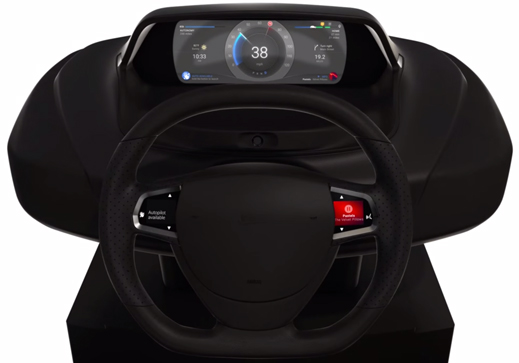New Dashboard Makes It Safer to Let Your Car Do the Driving
How do you make sure a driver doesn’t get too distracted when his or her car is doing the driving?

A new interface for cars, developed by the French automotive hardware supplier called Valeo, tries to answer this question with a new dashboard interface that spans a vehicle’s steering wheel and its instrument display and shows information from a user’s smartphone. The company says that recent user testing showed it could be a safer way of transitioning from automated driving back to human control.
Driver distraction is already a huge problem on the road, and smartphone use is implicated in more than 25 percent of all traffic accidents. This is why many carmakers are already allowing smartphone makers access to the entertainment consoles in cars (see “Rebooting the Automobile”). But the issue of driver distraction is likely to get more complicated as carmakers make it possible for cars to drive themselves some of the time, with research showing that it can take drivers more than 10 seconds to regain control of a vehicle in an emergency if they are fully distracted (see “Proceed with Caution toward the Self Driving Car”).
Carmakers are acutely aware of this issue, even as they tout the automated capabilities they are developing, and Valeo’s interface, called Mobius, offers a possible solution.
Once a car has entered automated driving mode, the display shows information from the driver’s own smartphone, but it combines that with information such as current speed and the direction of the next turn. The idea is that, because the display is also close to the driver’s view of the road, he or she should find it easier to retake control of the wheel when necessary.
“You can access the weather, the news, you can even play [games],” said Patrice Reilhac, director of innovation and collaborative research at Valeo, at an industry event. “At the same time, we keep some kind of situational awareness. And given that the screen is placed close to the road, people keep the road in their peripheral vision.”
The company recently tested the interface with 41 people at the Vehicle Interaction Lab at the Fraunhofer Institute in Germany. “What we found was astonishing,” Reilhac added. “The reaction time was below two seconds. Our idea, that people keep situational awareness through their peripheral vision, seems to be confirmed.”
Gregory Fitch, a research scientist specializing in user experiences at Virginia Tech’s Center for Automated Vehicles, says regaining control from a partially automated vehicle is a big challenge within the auto industry. His group recently conducted research with GM and Google that showed how easily drivers can misjudge what an automated vehicle is doing.
Mobius would also check to see if the driver’s eyes are on the road before handing control back to them. Other experts say this could also be a very important part of future vehicle interfaces.
Bryan Reimer, a researcher at the MIT Age Lab who studies vehicle interfaces, says driver monitoring is likely to become much more common, and also a crucial part of the interface. “Based upon the driver’s state, adaptive warnings can be more appropriately deployed,” he says. This could help minimize potentially dangerous confusion, Reimer suggests.
Keep Reading
Most Popular
Large language models can do jaw-dropping things. But nobody knows exactly why.
And that's a problem. Figuring it out is one of the biggest scientific puzzles of our time and a crucial step towards controlling more powerful future models.
The problem with plug-in hybrids? Their drivers.
Plug-in hybrids are often sold as a transition to EVs, but new data from Europe shows we’re still underestimating the emissions they produce.
Google DeepMind’s new generative model makes Super Mario–like games from scratch
Genie learns how to control games by watching hours and hours of video. It could help train next-gen robots too.
How scientists traced a mysterious covid case back to six toilets
When wastewater surveillance turns into a hunt for a single infected individual, the ethics get tricky.
Stay connected
Get the latest updates from
MIT Technology Review
Discover special offers, top stories, upcoming events, and more.